Snap One C416AMP3 Multi Channel Amplifier User Manual 200 00038 Rev A MultiChannelAmp
Control4 Multi Channel Amplifier 200 00038 Rev A MultiChannelAmp
Snap One >
Exhibit 8
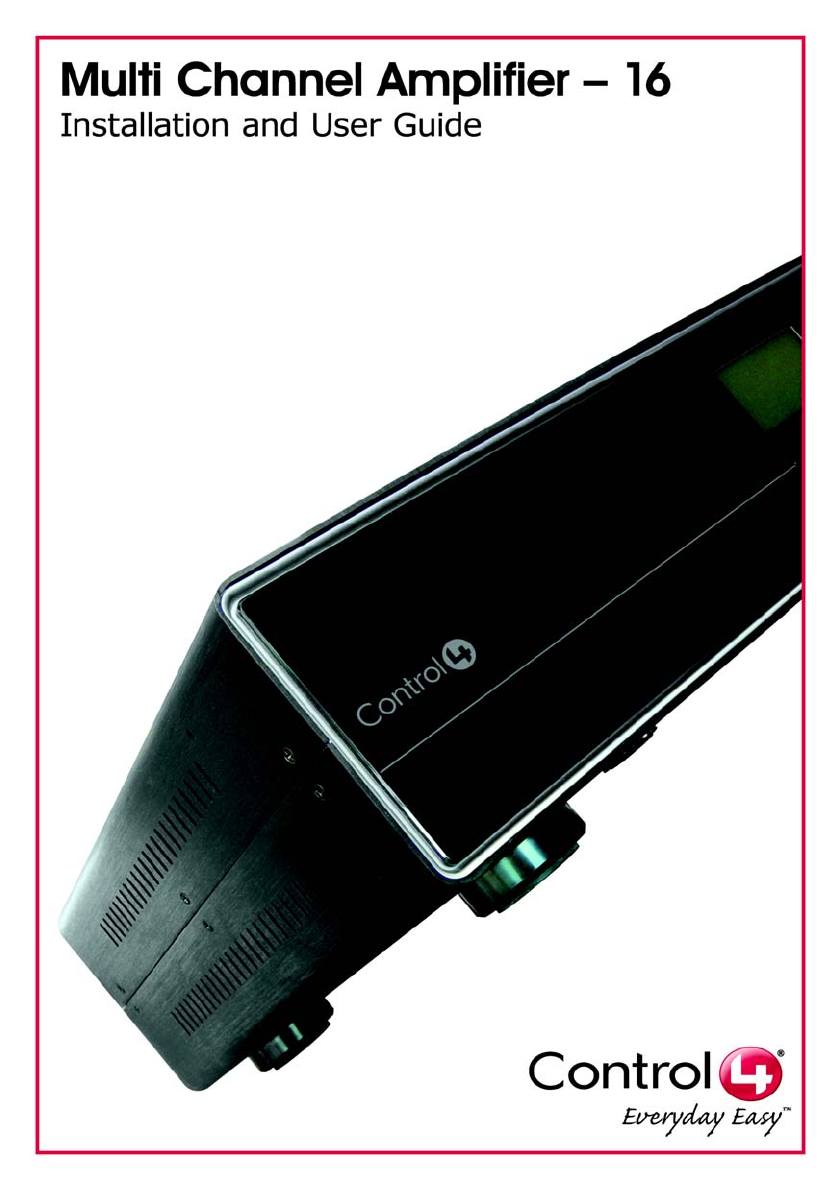
Disclaimer
Control4® makes no representations or warranties with respect to this
publication, and specifically disclaims any express or implied warranties of
merchantability or fitness for any particular purpose. Control4 reserves the
right to make changes to any and all parts of this publication at any time,
without any obligation to notify any person or entity of such changes.
Trademarks
Control4, EZ ID, and the Control4 logo are trademarks or registered
trademarks of Control4 Corporation. Other product and company names
mentioned in this document may be the trademarks or registered
trademarks of their respective owners.
Copyright
Copyright © 2004-2007 Control4. All rights reserved. No part of this
publication may be reproduced, photocopied, stored on a retrieval system,
or transmitted without the express written consent of the publisher.
Contact Us
Control4 Corporation
11734 S. Election Road
Salt Lake City, UT 84020 USA
http://www.control4.com
Multi Channel Amplifier - 16 Installation and User Guide
Part Number: 200-00038 Rev A
Hardware Model Number: C4-16AMP3-B

iii
Contents
Preface Important Information ....................................1
Graphical Symbols in this Guide............1
Graphical Symbols on the Device..........1
Safety Instructions .................................2
Additional Resources.............................3
Chapter 1 Introduction to Multi Channel Amplifier - 16...5
Features and Benefits............................5
Requirements ........................................6
What’s in the Box...................................6
About the Multi Channel Amplifier .........6
Front View.........................................6
Back View.........................................7
Chapter 2 Installing the Multi Channel Amplifier ............9
Plan Your Physical Layout...................10
Connect Audio Input Sources and
Speakers..............................................11
Connect to the Network and Power .....12
Set Up Logical Connections ................12
Set Network Settings ...........................13
Chapter 3 Using Multi Channel Amplifier .....................15
View Output Assignments....................15
Manage Amplifier Output Zones ..........17
View or Change Output Settings ....17
View or Change Input Settings .......19
View Network Settings.........................20
Set Display Preferences ......................20
Options Available in Composer ...........21
Chapter 4 Regulatory Compliance ...............................23
North America......................................23

iv
FCC Interference Statement...........23
Industry Canada Statement............23
Underwriters Laboratories Inc.........24
Recycling Information ..................... 24
Warranty .........................................24
Index .....................................................................................25

1
PREFACE Important Information
Graphical Symbols in this Guide
Warning, Important, and Note paragraphs draw your
attention to important safe practices and additional
information which may help you avoid injury, death, or loss
of material or time.
WARNING! This indicates a potentially hazardous
situation that, if not avoided, may result in death or serious
injury. DO NOT IGNORE A WARNING!
IMPORTANT! This indicates information that will help
you avoid damage to your equipment, loss of materials, or
loss of time. PAY ATTENTION TO THESE IMPORTANT
STATEMENTS!
NOTE: This indicates a note on related information
about the current topic.
Graphical Symbols on the Device
The following information has been placed on the device:

2
Safety Instructions
1. Read these instructions.
2. Keep these instructions.
3. Heed all warnings.
4. Follow all instructions.
5. Do not use this apparatus near water.
6. Clean only with dry cloth.
7. Do not block any ventilation openings. Install in
accordance with the manufacturer’s instructions.
8. Do not install near any heat sources such as
radiators, heat registers, stoves, or other apparatus
(including other amplifiers) that produce heat.
9. Do not defeat the safety purpose of the polarized or
grounding-type plug. A grounding-type plug has two
blades and a third grounding prong. The wide blade
or the third prong are provided for your safety. If the
provided plug does not fit into your outlet, consult an
electrician for replacement of the obsolete outlet.
10. Protect the power cord from being walked on or
pinched particularly at plugs, convenience
receptacles, and the point where they exit from the
apparatus.
11. Only use attachments/accessories specified by the
manufacturer.
12. Use only with the cart, stand, tripod, bracket, or table
specified by the manufacturer, or sold with the
apparatus. When a cart is used, use caution when
moving the cart/apparatus combination to avoid
injury from tip-over.
13. Unplug this apparatus during lighting storms or when
unused for long periods of time.
14. Refer all servicing to qualified service personnel.
Servicing is required when the apparatus have been
damaged in any way, such as power-supply cord or
plug is damaged, liquid has been spilled or objects

3
have fallen into the apparatus, the apparatus has
been exposed to rain or moisture, does not operate
normally, or has been dropped.
15. Do not install in a cabinet that is smaller than
20” wide x 20” deep x 12” high.
WARNING! Do not expose the apparatus to dripping or
splashing. Do not place objects filled with liquids near the
apparatus.
WARNING! To reduce the risk of fire or electrical shock,
do not expose this apparatus to rain or moisture.
WARNING! Equipment must be connected to a Mains
socket outlet with a protective earthing connection.
WARNING! To reduce the risk of fire, do not install in a
cabinet that is smaller than 20” wide x 20” deep x 12” high.
If you do, the device may overheat.
Additional Resources
The following resources are available:
`Your Control4-authorized reseller
`Control4 Web Site: http://www.control4.com/

4

5
CHAPTER 1Introduction to Multi
Channel Amplifier - 16
Control4 systems are uniquely configured for every
customer and every site. A popular component among
music lovers is the Control4 Multi Channel Amplifier.
This chapter introduces the Control4 Multi Channel
Amplifier - 16 and its features.
Features and Benefits
`Receives up to eight stereo inputs with full audio
switching on inputs.
`Outputs eight stereo class D amplified channels at
100 W per channel (not all driven simultaneously), or
at 40 W peak per channel (all channels driven).
`Adjustable gain, treble, and bass for each zone
`Master Volume Control for all outputs
`Control4 EZ ID™ LEDs for every I/O to make
connections easy to identify
`Device chassis is three standard rack spaces and
rack mountable configuring to EIA 19” rack standards.
Its dimensions are 5.25” x 17” x 16”.
`Communicates via Ethernet 10/100 port and ZigBee
mesh networking (IEEE 802.15.4).

6
Requirements
`Ensure that your home network wiring is in place
before starting your system setup. The Multi Channel
Amplifier can be controlled through Ethernet or
through ZigBee mesh networking (IEEE 802.15.4).
`Device must not be installed in a cabinet that is
smaller than 20” wide x 20” deep x 12” high.
What’s in the Box
The following hardware and software is required and
included in your Control4 Multi Channel Amplifier box.
`Control4 Multi Channel Amplifier - 16
`IEC power cord
`This manual
About the Multi Channel Amplifier
Front View
1. Front Display—LCD for displaying or setting
Multi Channel Amplifier settings and
navigating system menus. The front display
is used to view or modify audio source
1
2
3

7
routing and zone settings for gain, bass, and
treble. The display also shows zone activity.
2. Buttons—Provides access to menu options
displayed on the LCD.
3. Select Dial—Rotate to scroll through list
items and options displayed on the LCD.
Press to make selections.
Back View
1. Power Plug Port—For use with a standard
IEC equipment power cord. Use the supplied
power cord or ensure the power cord you are
using is at least 18 AWG or larger.
2. Ethernet Port—RJ-45 for a 10/100 BaseT
Ethernet connection
3. Audio Inputs 1-16—RCA jacks for 8 stereo
analog sources, and their supporting light
emitting diodes (LEDs) for EZ ID™ during
setup
4. Amplifier Outputs 1-16—5-way binding post
pair for 8 stereo class D amplified channels,
and their supporting LEDs for EZ ID™ during
setup
1
3
2
4

8
Technical Specifications
Multi Channel Amplifier - 16
Table 1: Multi Channel Amplifier - 16
C4-16AMP3-B Multi Channel Amplifier - 16
Communications: Ethernet 10/100 base and Zigbee
mesh networking
Connections: 8 sets of stereo inputs
8 sets of amplifier outputs
Dimensions: 5.25” x 17” x 16”
Display: LCD screen
Shipping weight: approximately 28 lbs

9
CHAPTER 2Installing the Multi
Channel Amplifier
This device operates as part of the Control4 home
system, which requires physical connections and logical
connections to function as designed.
The essential setup tasks are:
1.Plan Your Physical Layout
2.Connect Audio Input Sources and Speakers
3.Connect to the Network and Power
4.Set Up Logical Connections
5.Set Network Settings
This chapter describes, in general terms, how to set up
the physical connections required for the Multi Channel
Amplifier and all of the devices associated with it.
To set up the logical connections required, refer to
Control4 Composer User Guide software documentation.
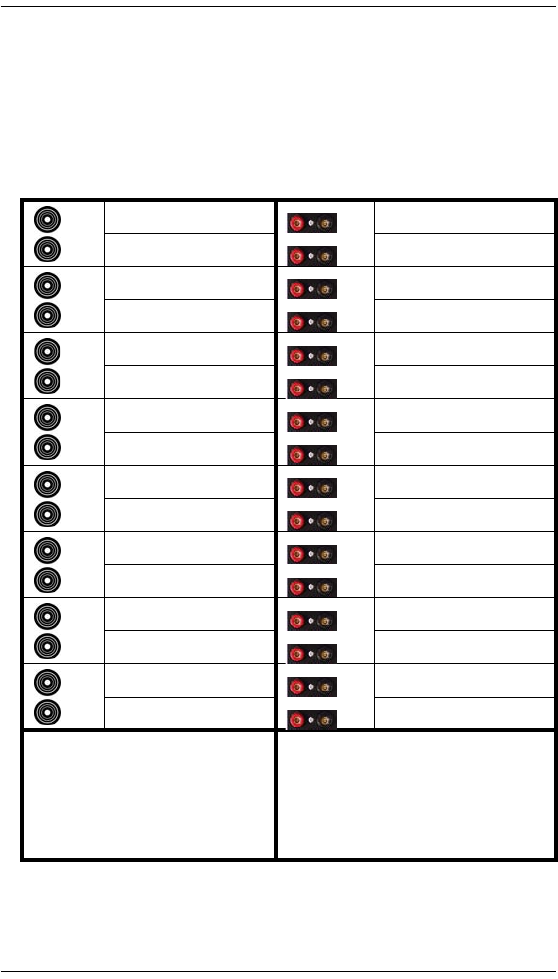
10
Plan Your Physical Layout
This section can help you plan your physical connections.
Use a worksheet to plan your amplifier connections: Using
the worksheet provided in Table 2-1 below, identify the
connection you will use for all planned connections.
Table 2-1. Multi Channel Amplifier Connection Worksheet
8
A 8 B
7
A 7 B
6
A 6 B
5
A 5 B
4
A 4 B
3
A 3 B
2
A 2 B
1
A 1 B
Audio
Inputs—
8 stereo sources
Input examples:
CD changers,
VCRs, TVs, DVD
changers, or
Media Controllers
Amplifier
Outputs—
8 stereo channel
outputs
Output examples:
Speakers

11
WARNING! Connecting speaker wires or input
cables while the Multi Channel Amplifier is powered,
may cause shock and could damage the amplifier.
Connect Audio Input Sources and
Speakers
1. Ensure the amplifier power cord is unplugged before
connecting speakers and audio sources.
2. Connect up to eight stereo audio source devices to
the RCA line level input jacks (the top row of
connector on the back of your amp). Sources may
include line level audio outputs from devices such as
a Control4 Home Theatre Controller or Media
Controller, tuners, CD or tape players, etc. Use the
worksheet on the previous page to keep track of
which source is connected to which amplifier input.
3. Connect speakers to the audio output jacks. Tighten
the binding posts to ensure a good electrical
connection to the speaker wires (even if you are
using banana plugs, it is important to tighten the
binding posts). Do not bridge outputs. The outputs on
the C4-16AMP3 cannot be bridged. Do not connect
black terminals together. Do not connect the black
terminals to ground. The black terminals are not at
ground potential and connecting them together or to
ground can damage the amplifier. Use the work sheet
on the previous page to keep track of which speaker
zones are attached to which amplifier output
channels.

12
Connect to the Network and Power
1. If you are using an Ethernet connection for the Multi
Channel Amplifier, use a standard 10/100 Base T
Ethernet cable to connect the Ethernet port on the
amplifier to your network.
NOTE: While the Multi Channel Amplifier can be
controlled via either Zigbee or Ethernet networks,
Control4 recommends that you use an Ethernet
connection whenever possible as this will allow firmware
upgrades to be performed on the product. The firmware
on the amplifier cannot be upgraded over the Zigbee
network.
2. Connect the power cord provided to the back of the
Multi Channel Amplifier and to the power outlet. Once
the power cord is connected, the Multi Channel
Amplifier should power up.
Set Up Logical Connections
Physical and logical connections are required in order to
control, navigate, and use the Multi Channel Amplifier as
designed.
Thus far you have set up the physical connections for the
Control4 Multi Channel Amplifier. To complete the logical
setup, use Control4 Composer Pro software (available to
trained installers only) installed on a PC connected to the
home network. For instructions, refer to the Control4
Composer Pro User Guide.
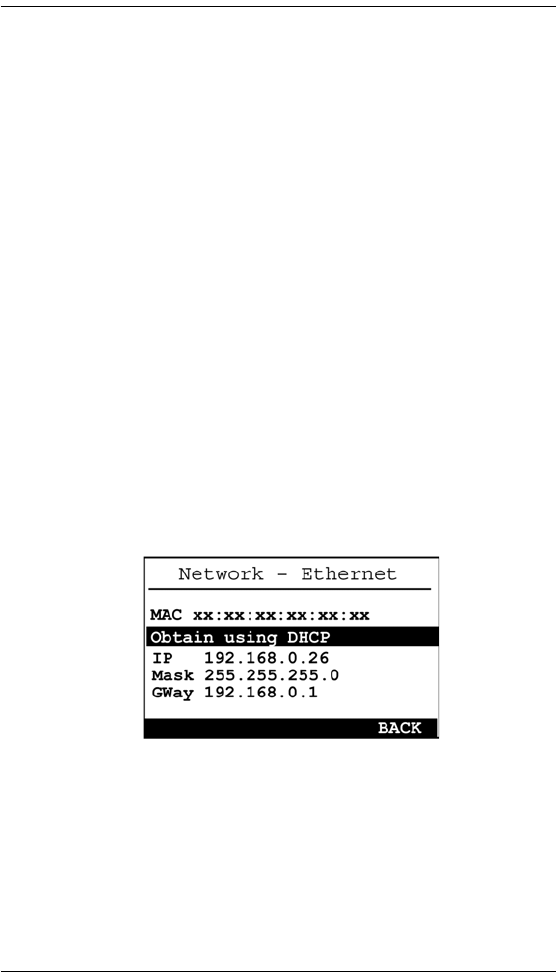
13
Set Network Settings
1. At the LCD screen, press the Network button.
2. On the Network Configuration screen, choose an
Ethernet or ZigBee network by rotating and pressing
the Select Dial.
3. If the amplifier is set to use a ZigBee network, the
EUID, Gateway, and ZigBee channel number are
displayed. The EUID and Gateway are static fields.
The Zigbee channel number can be changed.
Press the Select Dial to enter edit mode. Rotate the
dial or use the Up or Down button to change the
channel number.
This screen has one menu option:
`Back: Returns to the Network Configuration
screen.
4. If the switch is set to use an Ethernet network, the
MAC, method of obtaining a network IP address, IP
address, Mask, and GWay are displayed.
The Audio Matrix Switch, by default, uses DHCP to
obtain a network IP address.
If the local area network does not support DHCP, you
can configure the switch to use a Static IP address
instead:
4a. Press the Select Dial to enter edit mode.
4b. Press the Down or Up button (or rotate the
Select Dial) to choose Static IP.

14
4c. Press OK (or press the Select Dial).
4d. Press Save (or press the Select Dial).
4e. Edit the IP, Mask, and GWay fields for the
Static IP network: Use the Select Dial to
select a line, then press the dial.
Use the Select Dial scroll the number up or
down and edit as needed, then press the
Select Dial to move to the next field within
the number.
4f. When finished editing, press Save.
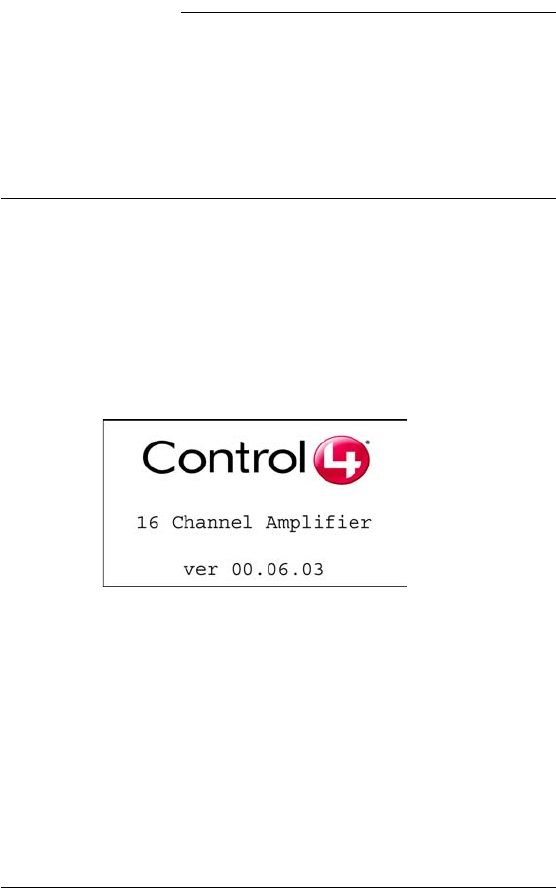
15
CHAPTER 3Using Multi Channel
Amplifier
This chapter introduces the LCD user interface screens
on the Multi Channel Amplifier and the common system
tasks you can perform. Normal day-to-day tasks do not
require manual control but instead are controlled using
the Control4 user interface.
View Output Assignments
Once you complete the physical connections and logical
connections (using the Composer software as needed),
you can view or change your setup in the Multi Channel
Amplifier front display.
When you first power up the Multi Channel Amplifier, a
System Status screen similar to the following one appears
momentarily.
The System Status screen is then replaced by the
In to Out Assignments screen. The screen shows 8 output
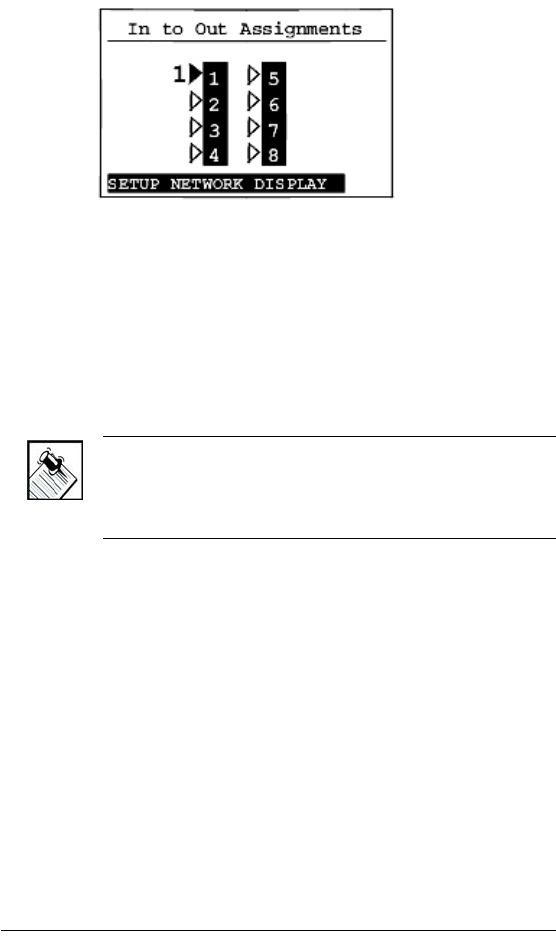
16
zones and any assigned input sources (such as Input 1 as
shown in the following screen).
A shaded arrowhead indicates that a signal is present.
The menu buttons on the front panel provide access to the
following screen:
`Setup: Displays an output-specific screen, such as
Output Zone 1.
`Network: Displays the Network Configuration screen.
`Display: Displays the Display Configuration Screen.
NOTE: After leaving the Setup, Network, or Display
menu and returning to the In to Out Assignments screen,
you may need to wait for the screen to load before
selecting another menu.
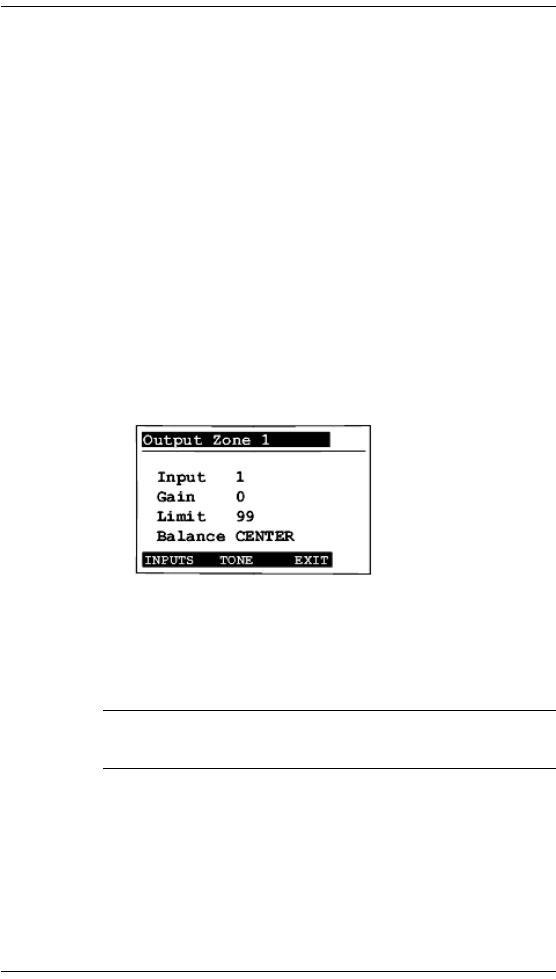
17
Manage Amplifier Output Zones
View or Change Output Settings
To view or change source settings:
1. On the In to Out Assignments screen, press the
Setup button.
The output settings of the default output screen (the
last output screen accessed) are displayed.
In the following example it is Output Zone 1. You can
choose to view the settings for a different output
screen by changing the output number (see Step 2).
You can adjust the output settings by scrolling with
the Select Dial, pressing the dial to edit, using the up
or down button or the dial to change the setting, and
pressing OK or the Select Dial to save changes.
`Input (number): If an input source is assigned,
the Input source number is displayed (1 - 16).
`Gain (setting): Supported range: Mute INF
0 - 99 (-100 to 0 dB)
NOTE: The gain setting cannot be larger than the
volume limit.
`Limit: Set a volume limit. Options are 0 - 99 or
off.
`Balance: Determine output balance. Options
are Center, Left, Right, L-1 - L-19, or R-1 - R-19.

18
`Menu buttons: Provide access to these screens:
Inputs: Toggles view to a screen showing the
gain for the currently assigned input.
Tone: Displays the bass gain, bass frequency,
treble gain, and treble frequency for this output.
Exit: Returns to the In to Out Assignments
screen.
2. (Conditional) View a different output number: If the
output screen that you want to view is not displayed,
use the Select Dial to select and change the output
number at the top.
3. (Optional) Change an output setting:
3a. Using the Select Dial, highlight the Input, Gain,
Limit, or Balance field and then press the Select
Dial to enter Edit mode.
3b. Turn the Select Dial (or use the Up/Down
buttons) to set a new number and then press the
dial to save the setting.
`Input: 1-16
`Gain: Mute, 0 - 99 (-100 to 0 dB)
`Limit: Off, 0-99
`Balance: Center, Left, Right, L-1 - L-19, R-
1 - R-19
4. (Optional) Change a tone setting:
4a. From the Output screen, press the Tone button.
Page 2 of the selected output screen is
displayed.
4b. Rotate the Select Dial to highlight a tone setting.
`Bass Gain: Supported range: -12 to +12 dB
`Bass Freq: Supported range: 40 to 315 Hz
(in 1/3 octave increments)
`Treb Gain: Supported range: -12 to +12 dB
`Treb Freq: Supported range: 2500 to
16000 Hz (in 1/3 octave increments)

19
If you choose to edit the Treb Freq field, a
new menu is displayed at the bottom of the
screen, which includes the options Down,
Up, OK, and Cancel. You can use these
menu options to change this setting or
continue using the Select Dial as you have
previously done.
4c. Press the Select Dial to enter Edit mode.
4d. Rotate the dial to change the setting. Press the
dial to save the new setting and exit the Edit
mode. To exit without saving, use the front panel
button indicated to choose Cancel.
4e. Press a menu button to view a new screen:
`Outputs: Returns to the previous Output
screen.
`Exit: Returns to the In to Out Assignments
screen.
View or Change Input Settings
1. On the In to Out Assignments screen, press the
Setup button to display the Output screen.
2. From the Output screen, press the Inputs button to
display the assigned Input screen (similar to the
following screen).
From here you can change the Gain setting or
choose one of these menu options.
`Outputs: To toggle back to the Output screen
`Exit: To return to the In to Out Assignments
3. (Optional) Change the Gain on an input source in
order to balance unequal source levels by reducing
the levels of any louder sources: Use the Select Dial
to highlight, select, and change this setting. This sets
the input attenuation. Supported range is -6 to 0 dB.
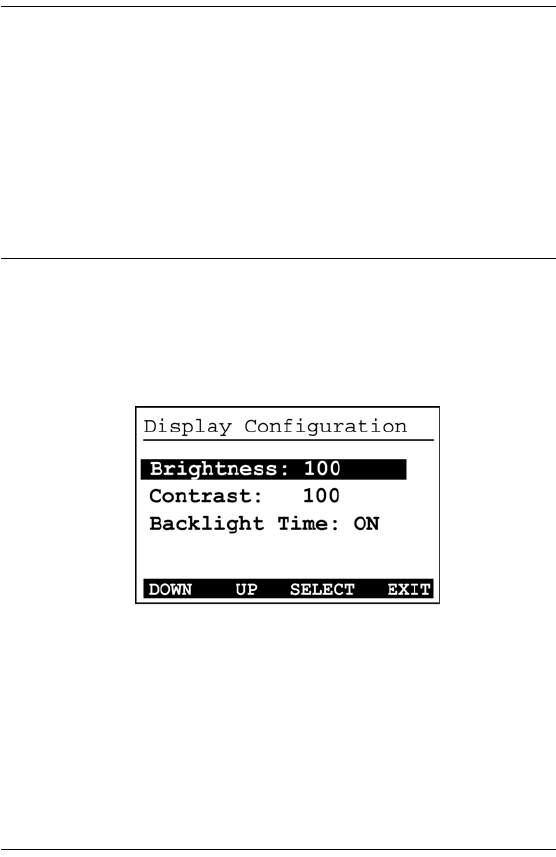
20
4. (Optional) Press the Outputs button to toggle back to
the last Output screen that was accessed.
5. Press the Exit button to return to the In to Out
Assignments screen.
View Network Settings
1. On the In to Out Assignments screen, press Network.
To display the network settings, select Ethernet or
Zigbee (depending on which the amp uses).
2. To edit these settings, see Set Network Settingson
page 13.
3. Press the Back button to return to the In to Out
Assignments screen.
Set Display Preferences
To set your viewing preferences for the front display:
1. On the In to Out Assignments screen, press the
Display button. The Display Configuration screen is
displayed.
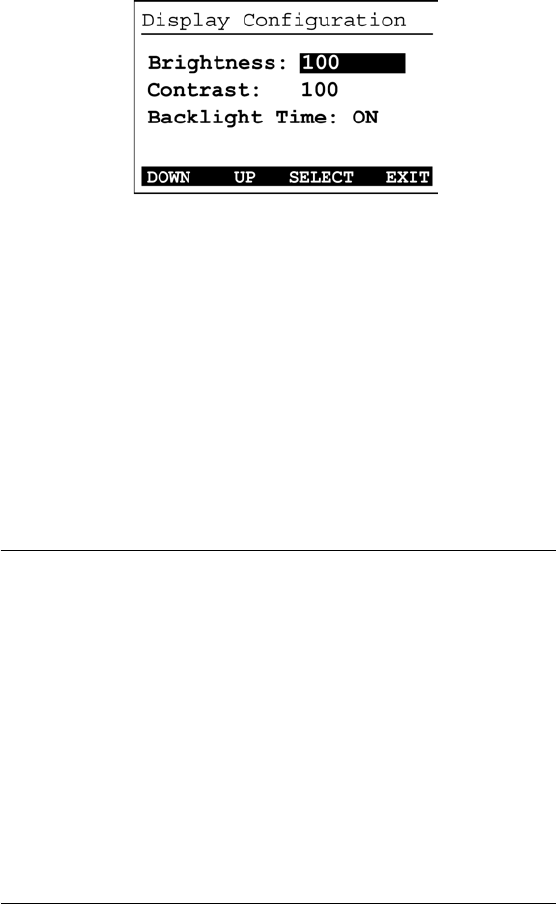
21
2. Use the buttons or the Select Dial to choose a setting
to change: Once you press the Select button (or
press the dial), you enter Edit mode.
3. In Edit mode, use the buttons or Select Dial to
change the highlighted setting. Press the OK button
(or press the dial) to save the change and exit Edit
mode.
Brightness: Supported range: 0 to 100
Contrast: Supported range: 0 to 100
Backlight Timeout: Supported settings are
`Off (always off)
`1 to 90 seconds (default is 10 seconds)
`On (always on)
4. Press the Exit button to return to the In to Out
Assignments screen.
Options Available in Composer
The following options are available in Composer:
Volume curve: The volume curve default
follows the Control4 speaker-point volume
curve. The volume curve can be changed to
match the V1 curve using Composer.
5-band parametric equalizer: A 5-band
parametric equalizer is available in
Composer for tighter output control.

22

23
CHAPTER 4Regulatory Compliance
This product complies with the standards and practices referenced in this
section for North America, Europe, or Australia/New Zealand.
North America
FCC Interference Statement
This device complies with Part 15 of the FCC Rules. Operation is subject
to the following two conditions: (1) This device may not cause harmful
interference, and (2) this device must accept any interference received,
including interference that may cause undesired operation.
This equipment has been tested and found to comply with the limits for a
Class B digital device, pursuant to Part 15 of the FCC Rules. These limits
are designed to provide reasonable protection against harmful interference
in a residential installation. This equipment generates, uses, and can
radiate radio frequency energy and, if not installed and used in accordance
with the instructions, may cause harmful interference to radio
communications. However, there is no guarantee that interference will not
occur in a particular installation. If this equipment does cause harmful
interference to radio or television reception, which can be determined by
turning the equipment off and on, the user is encouraged to try to correct
the interference by one of the following measures:
`Reorient or relocate the receiving antenna.
`Increase the separation between the equipment and receiver.
`Connect the equipment into an outlet on a circuit different from that to which the
receiver is connected.
`Consult the dealer or an experienced radio/TV technician for help.
IMPORTANT! Changes or modifications not expressly
approved by Control4 could void the user’s authority to
operate the equipment.
Industry Canada Statement
This Class B digital apparatus complies with Canada ICES-003.
Cet appareil numérique de la classe B est conforme à la norme
NMB-003 du Canada.

24
Underwriters Laboratories Inc.
This product has been tested by UL and has been found to be in
compliance with: UL 60065, Second Edition, “Standard for Audio/Video and
Musical Instrument Apparatus for Household, Commercial, and Similar
General Use”
CSA C22.2 No. 60065-03, First Edition: 2006 “Audio, Video and Similar
Electronic Equipment”
Recycling Information
For information on recycling, please go to www.control4.com/
recycling
Warranty
This device has a limited two (2) year warranty on parts from the date
of purchase. Control4 will replace or repair any defective unit. Return
unit to the place of purchase for replacement. For any damages
incurred, the warranty will never exceed the purchase price of the
device. This warranty does not cover installation, removal, or
reinstallation cost. The warranty is not valid in cases where damage
was incurred due to misuse, abuse, incorrect repair, or improper wiring
or installation. It does not cover incidental or consequential damage.
This warranty gives you specific legal rights, and you might also be
entitled to other rights that vary from state to state. Some states do not
allow limitations on how long an implied warranty lasts or the exclusion
or limitation of incidental or consequential damages. In these cases,
the above mentioned limitations might not apply to you. For complete
warranty information, see www.control4.com/warranty.

25
Index
Numerics
5-Band Parametric Equalizer 21
A
Additional Resources 3
Amplifier Outputs 7
Audio Input
Connect Audio Input Sources and Speakers 11
Audio Inputs 7
Change Settings 19
Connect Audio Input Sources and Speakers 11
View Settings 19
B
Backlight Timer 21
Balance 17
Bass Freq 18
Bass Gain 18
Brightness 21
Buttons 7
C
Connections
Connect Power 12
Connect to Power 12
Connect to the Network 12
Logical Connections 12
Contrast 21

26
D
Display
Set Preferences 20
Settings
Backlight Timer 21
Brightness 21
Contrast 21
Display Button 16
E
Ethernet 13
DHCP 13
Static IP 13
Ethernet Port 7
F
Features and Benefits 5
Front Display 6
G
Gain 17
IImportants 1
In to Out Assignments Screen
Menu Buttons 16
Input 17
Installation
Connect Audio Input Sources and Speakers 11
Connect to the Network and Power 12
Logical Connections 12
Network Settings 13
Physical Layout 10

27
L
Limit 17
M
Menu Buttons (Assignments Screen) 16
Display 16
Network 16
Setup 16
Menu Buttons (Output Screen) 18
Inputs 18
Tone 18
Menu Buttons (Output)
Tone 18
Menu Buttons (Tone)
Exit 19
Outputs 19
Multi Channel Amplifier 6
Amplifier Outputs 7
Audio Inputs 7
Back View 7
Buttons 7
Connection Worksheet 10
Ethernet Port 7
Front Display 6
Front View 6
Power Plug Port 7
Select Dial 7
Multi Channel Amplifier Connection Worksheet 10
N
Network
Connect to the Network 12
Ethernet 13
Settings 13
View Settings 20
Zigbee 13

28
Network Button 16
notes 1
O
Options Available in Composer 21
5-Band Parametric Equalizer 21
Volume Curve 21
Output
Change Settings 17
Menu Buttons 18
Inputs 18
Tone 18
Settings
Balance 17
Gain 17
Input 17
Limit 17
View Output Assignments 15
View Settings 17
P
Power Plug Port 7
R
Recycling Information 24
Regulatory Compliance 23
Requirements 6
S
Safety Instructions 2
Select Dial 7
Setup Button 16
Speakers
Connect Audio Input Sources and Speakers 11
Static IP 13
System Status Screen 15

30
